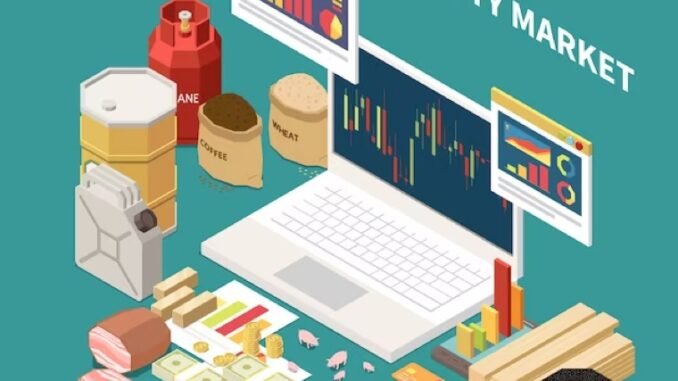
Delving into the multifaceted realm of economics, one encounters the intriguing world of commodity markets, which function as the bedrock of global trade.
India, with its vast agricultural expanse and rich mineral resources, offers a vibrant landscape for such activities. This article takes you through a comprehensive exploration of the commodity market in India.
Understanding the Commodity Market in India
In essence, the commodity market is a platform where various commodities are bought, sold, or traded, usually in the form of futures contracts. These commodities encompass a broad array of goods, from precious metals like gold and silver to agricultural produce such as wheat, rice, and spices, to energy resources like crude oil and natural gas.
The commodity market in India has its genesis in the establishment of the Bombay Cotton Trade Association in 1875. Over the years, it has significantly evolved and expanded, manifesting itself in its present form through the establishment of national commodity exchanges such as Multi Commodity Exchange of India (MCX), National Commodity and Derivatives Exchange (NCDEX), and Indian Commodity Exchange (ICEX).
Structure and Regulation of the Commodity Market
The structure of India’s commodity market is robust and well-regulated. The chief regulatory body is the Securities and Exchange Board of India (SEBI), responsible for safeguarding the interests of investors and ensuring a transparent and efficient market. SEBI monitors the exchanges and sets rules and guidelines that must be followed.
In addition, each commodity exchange has a governing body, an exchange board, and a set of members or brokers through which retail investors can trade. Every participant must abide by the stipulated regulations to maintain a fair and competitive market.
Trading in the Commodity Market
Commodity trading in India primarily operates through futures contracts, a derivative instrument. A futures contract is an agreement between two parties to buy or sell a specific quantity of a commodity at a predetermined price, at a future date. This mechanism provides a hedge against price volatility and risk management for investors.
The market participants are typically hedgers, speculators, and arbitrageurs. Hedgers use futures contracts to mitigate the risk of price change in the commodities, while speculators capitalize on the price volatility to make profits. Arbitrageurs, on the other hand, take advantage of price differences in different markets.
If this topic interests you, you can also read What is RSI in the stock market?
Challenges and Opportunities
Despite its vast potential, the commodity market in India faces several challenges. Key among them is the lack of awareness and understanding among potential investors. Moreover, inadequate infrastructure, price manipulation, and policy constraints further hamper the growth and development of the market.
However, the outlook isn’t all bleak. Opportunities abound in the form of untapped commodities, technological advancements, and government initiatives. The introduction of options trading and the push towards farmer participation have opened up new avenues in the market. With a strategic focus on addressing the challenges, the commodity market in India holds tremendous potential for growth and prosperity.
The Role of Technology in the Commodity Market
Technology is a transformative force in the world of commodity trading. From improving market transparency to facilitating efficient trade executions, the impacts are far-reaching. Online trading platforms offer real-time price tracking, instant trade execution, and a plethora of analytical tools, enabling traders to make informed decisions swiftly.
Moreover, blockchain technology and smart contracts are poised to revolutionize commodity trading and supply chain management by enhancing traceability and reducing transaction costs. Agri-tech advancements such as precision farming and climate-smart technologies can help predict agricultural yield, influencing commodity prices and market trends.
Trading Strategies in the Commodity Market
Trading strategies in the commodity market are designed based on several factors, such as risk appetite, market conditions, and the trader’s understanding of the commodity.
- Trend Following: Traders who follow this strategy believe that commodities that have been rising will continue to rise, and those that have been falling will continue to fall. They use technical analysis tools to identify trends and make their trades.
- Range Trading: This strategy is used when a commodity’s price is moving within a specific range. Traders buy at the low end of the range and sell at the high end.
- Fundamental Trading: This strategy is based on the analysis of fundamental factors like supply and demand conditions, geopolitical events, weather patterns (for agricultural commodities), etc.
- Spread Trading: This strategy involves the simultaneous buying and selling of two related commodities. The idea is to profit from the change in the price difference between the two commodities.
Most Traded Commodities in India
Commodity trading in India is diverse, featuring a wide variety of commodities.
- Precious Metals: Gold and silver are the most commonly traded commodities due to their high value and liquidity.
- Energy: Crude oil and natural gas are highly traded due to their critical role in global energy consumption.
- Agricultural Commodities: India being an agrarian economy, agricultural commodities like wheat, rice, cotton, and spices are heavily traded.
- Base Metals: Commodities like copper, zinc, and aluminium, used extensively in various industries, also see significant trading volumes.
Conclusion
The commodity market in India is a dynamic and exciting field, presenting a multitude of opportunities for traders, investors, and stakeholders. From the traditional trading of agricultural commodities to the advanced technological interventions of today, the journey has been phenomenal. As we embrace digital transformation, the future of the commodity market in India promises to be vibrant, inclusive, and prosperous.
The commodity market in India is a fascinating platform replete with numerous possibilities. While it presents its share of challenges, it also provides a plethora of opportunities, making it an intriguing arena for investors, traders, and researchers alike.
As we move towards a future marked by increasing globalization and digitalization, the commodity market in India is poised to chart new territories and attain greater heights. You can also read more such blogs on Papaya Digitals.



